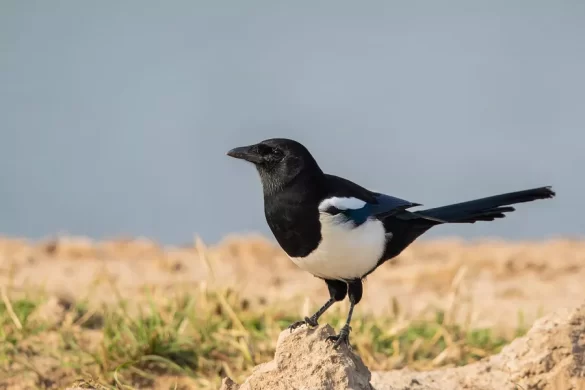Magpies are well-known birds that have captured the attention of nature enthusiasts and researchers alike due to their striking appearance and intriguing behavior. Among the most recognizable and widely distributed species are the Black-billed Magpie (Pica hudsonia) and the Eurasian Magpie (Pica pica). While both birds share similarities, they also possess distinct characteristics that set them apart. This article aims to explore the key differences between these two magpie species.
Physical Appearance
Black-billed Magpie: The Black-billed Magpie is predominantly found in North America and is known for its contrasting black and white plumage. The head, wings, and tail are primarily black, while the body is adorned with white feathers on the belly and sides. Its iridescent black tail feathers contribute to its unique appearance.
Eurasian Magpie: The Eurasian Magpie, native to Europe and parts of Asia, also boasts black and white plumage, but with notable differences. Its back and wings are predominantly black, and it features a long, elegant tail. The most distinct feature of the Eurasian Magpie is its iridescent blue or greenish-blue patch on its wings, which is absent in the Black-billed Magpie.
See Also: What is a Eurasian Magpie?
Range and Habitat
Black-billed Magpie: The Black-billed Magpie is primarily found in western North America, spanning from Alaska to central Mexico. It prefers a variety of habitats, including open woodlands, grasslands, and agricultural areas. This species has adapted well to human-altered landscapes and can often be seen in suburban and urban environments.
Eurasian Magpie: The Eurasian Magpie’s range extends across Europe, Asia, and parts of North Africa. It thrives in diverse habitats, including woodlands, gardens, parks, and even urban areas. Like the Black-billed Magpie, it has demonstrated adaptability to human presence.
Behavior and Vocalizations
Black-billed Magpie: Black-billed Magpies are known for their curious and intelligent behavior. They are skilled at scavenging and are opportunistic feeders, consuming a wide range of food items, including insects, fruits, and small vertebrates. These magpies are highly social birds, often seen in groups called “parliaments.” Their vocalizations include a variety of calls, from melodious songs to harsh screeches.
Eurasian Magpie: Eurasian Magpies are also highly intelligent birds, often associated with their affinity for shiny objects. Their diet is diverse, encompassing insects, small animals, fruits, and even human food scraps. They are also social creatures, forming groups or pairs, and their vocal repertoire includes a mix of melodious notes, harsh calls, and mimicry of other bird species.
Breeding and Reproduction
Black-billed Magpie: Black-billed Magpies typically breed in the spring, constructing large, dome-shaped nests in trees or shrubs. These nests are often visible and can be quite elaborate, made from twigs, grasses, and other materials. The female incubates the eggs while the male helps to gather food. The chicks hatch after a few weeks and are cared for by both parents.
Eurasian Magpie: Eurasian Magpies also breed during the spring, building distinctive large nests in trees, bushes, or even on the ground. These nests are constructed from twigs, grass, and mud, forming a sturdy cup shape. Like their North American counterparts, both parents participate in incubation and chick-rearing duties.
Conclusion
While the Black-billed Magpie and the Eurasian Magpie share some common traits, such as their black and white plumage, intelligent behavior, and social nature, there are several key differences that distinguish them. The most notable distinctions lie in their geographic ranges, specific plumage features, and the presence of iridescent patches. Additionally, their vocalizations, breeding habits, and nesting behaviors exhibit subtle variations that highlight the unique aspects of each species. Whether in North America or Eurasia, these magpies continue to intrigue bird enthusiasts, researchers, and casual observers, serving as captivating examples of avian diversity and adaptation.


 Facebook
Facebook  Instagram
Instagram  Youtube
Youtube 